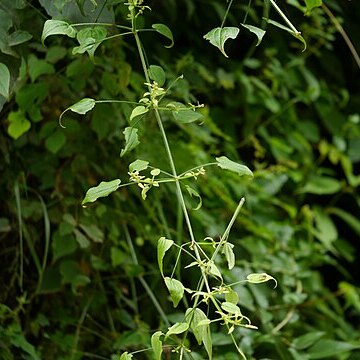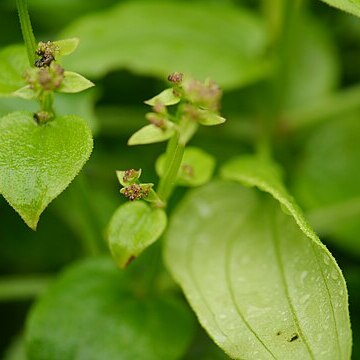Vines, herbaceous, drying with reddish cast; stems to 3 m, quadrangular, glabrous, retrorsely aculeolate to smooth, with red pith. Leaves in whorls of 4, equal or unequal; petiole 0.8-4 cm, sparsely aculeolate; blade drying papery, mostly greenish adaxially and purplish red abaxially, oblong-lanceolate, ovate-lanceolate, or ovate, (2.5-)4-6(-8.5) × (0.8-)1.8-2.5(-4) cm, length/breadth index 2-3, both surfaces glabrous and scaberulous, base rounded to cordate, margin flat to thinly revolute, aculeolate, apex long acuminate or caudate; principal veins (3 or)5(or 7), palmate. Inflorescences thyrsoid, paniculate, with terminal and axillary, many-flowered and 2.5-10 cm long cymes; axes glabrous and smooth to sparsely aculeolate; bracteoles elliptic-oblong or lanceolate, 0.5-2 mm; pedicels 1.5-3.5 mm. Ovary ca. 0.5 mm, smooth. Corolla red, purplish red, or orange, rotate, glabrous, fused basal part 0.5-0.6 mm; lobes 5, lanceolate to triangular, 1.2-1.5 cm, acuminate. Mericarp berry dark red, 3.5-5 mm in diam. Fl. Jul-Aug, fr. Oct.
More
A climber. It keeps growing from year to year. The stems can be 3 m long. They are angular. The leaves are in rings of four. They are 4-6 cm long by 2-3 cm wide. The flowers are cream-yellow or red. They forms large groups in the axils of leaves. The fruit is a dark red berry 4-5 mm across.
It is a temperate to subtropical plant. It grows up to 3000 m altitude in Uttar Pradesh in India. In the Indian Himalayas it grows between 1,300-3,000 m above sea level. In Sichuan and Yunnan.
More
Growing on shrubs, 1200-2700 metres.


